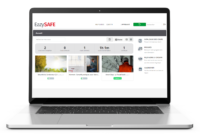Why Blended Learning is the Future of Health & Safety Training
Introduction: The Evolution of Workplace Training
Workplace safety training is no longer limited to traditional classroom sessions. With the rise of technology and the need for flexible learning, blended learning—a combination of online and in-person training—has emerged as the most effective way to deliver Health & Safety education. Companies are now adopting this method to ensure compliance, engagement, and retention of crucial safety protocols.
What Is Blended Learning?
Blended learning integrates digital training methods with face-to-face instruction, creating a well-rounded learning experience. It allows employees to complete theoretical components online at their own pace while participating in practical, hands-on sessions to reinforce key concepts.
For example, a construction worker may take an online course on hazard identification before attending an in-person workshop on using safety equipment. This approach ensures both knowledge acquisition and practical application.
Blended Learning is Key to Modern Health & Safety Training

Increased Accessibility and Flexibility:
Traditional training often requires employees to attend scheduled sessions, which may disrupt workflow. Blended learning enables them to complete modules online at their convenience, reducing downtime while maintaining learning continuity.

Improved Knowledge Retention:
Studies show that interactive learning leads to better information retention. Employees can revisit digital training materials, take quizzes, and engage in real-world scenarios before applying their knowledge in hands-on safety drills.

Cost-Effective and Scalable:
Blended learning reduces travel expenses, instructor fees, and printed materials by shifting a significant portion of training online. It also allows companies to scale safety training across multiple locations without logistical constraints.

Compliance and Tracking Made Easy:
Online learning platforms automate compliance tracking by keeping records of completed courses, certifications, and assessments. This helps organizations stay compliant with industry regulations and prepare for audits.

Engagement Through Interactive Learning:
Blended learning incorporates videos, simulations, and gamification, making safety training more engaging than traditional lectures. Employees are more likely to retain critical information when they actively participate in their learning process.
1. Assess Training Needs:
Identify which safety topics can be delivered online and which require in-person training.
2. Choose the Right Platform:
Use an online learning management system (LMS) to track progress, certifications, and compliance.
3. Combine Digital & Practical Training:
Allow employees to complete theoretical modules online before attending on-site practical workshops.
4. Encourage Engagement:
Utilize videos, quizzes, and real-life scenarios to make learning interactive.
5. Evaluate and Adapt:
Gather feedback and update training programs to ensure continuous improvement.
How Fit2Trade Enhances Blended Learning for Health & Safety Training
Fit2Trade offers a range of blended learning courses designed to make workplace safety training more effective and accessible. Through their platform, companies can provide employees with:
- Online Safety Modules – Covering essential topics like risk assessments, emergency procedures, and compliance regulations.
- Virtual Simulations & Interactive Scenarios – Enhancing learning through real-world applications.
- Instructor-Led Practical Training – Ensuring employees can apply knowledge in a supervised, hands-on environment.
- Automated Progress Tracking & Certification – Helping organizations monitor compliance and training effectiveness.
By leveraging Fit2Trade’s innovative blended learning solutions (Explore Courses Here), businesses can enhance safety awareness, improve compliance, and create a culture of continuous learning.
Conclusion: The Future of Workplace Safety Training
Blended learning is revolutionizing Health & Safety training by making it more accessible, cost-effective, and engaging. Companies that adopt this approach not only improve compliance but also create safer and more knowledgeable workplaces.
With Fit2Trade’s comprehensive blended learning courses, organizations can future-proof their safety training programs while ensuring employees receive high-quality, flexible education.
Start implementing blended learning today and build a safer workplace!

TAILORED TRAINING
Discover our safety training courses and ehs onboardings, which can be customised and offered in several languages.

SAFETY MANAGEMENT
Ensure the distribution of your safety policy by training your permanent, temporary or seasonal staff.

GLOBAL MONITORING
Simplify the management of your safety policy thanks to the numerous dashboards and training reports.
